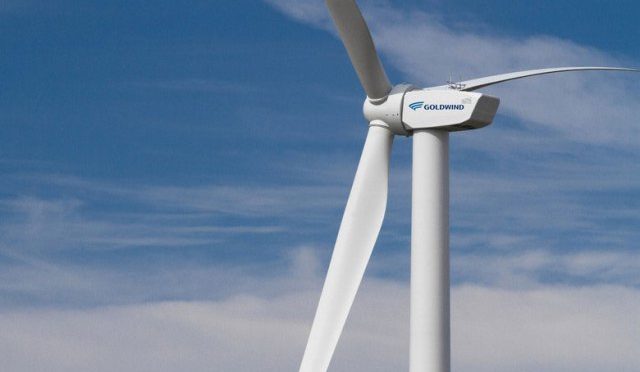“In the past decade, the LCOE of global onshore wind energy has fallen by about 25%, while the LCOE of onshore wind power in China has fallen by over 40%. By 2020, the on-grid price of wind farm projects can compete with that of coal-fired power projects and the on-grid price of PV projects will be reduced to the level of sales price set by the grid. Wind power is entering an era of grid parity,” said Mr. Liu Rixin, Vice President of Goldwind, at the 2019 China Wind Power Industry Innovation and Development Forum on May 22, 2019.
In the past 10 years, the efficiency of wind power generation in China has increased by 20% to 30%, the energy production has increased by 2% to 5%, and the operation and maintenance (O&M) cost has decreased by 5% to 10% through technological innovation such as high tower, airfoil optimization, independent pitch, cluster control, optimization of environmental control system, coating improvement and wind measurement technology.
In the past 20 years, with the help of technological innovation and scale effect, China’s wind turbines price has fallen by 70%, to 3,550 yuan/kW; the cost of wind farm construction has dropped by 50%, to 7,160 yuan/kW. The performance and reliability of power generation have been further improved.
Under the guidance of national policy, China’s renewable energy will gradually achieve grid parity, its cost will even be lower than fossil fuel in the future, which is a common goal for renewable energy. According to the growing trend of energy, wind power will gradually transform from supplementary energy to alternative energy as it is renewable and its cost will decrease.
From the industrial point of view, the grid parity needs 2 to 3 years to materialize, which will be a reality in 2021. Mr. Liu Rixin suggested to give more time to sort out the tiered pricing for grid parity, as the design and R&D of wind turbine as well as the costs of wind power supply chain have been locked.
In terms of wind resources and current construction cost, some provinces and cities like Shanghai and Fujian are ready, but further improvements in technology and business model are required if a nationwide grid parity or low price is to be in place.
After an overall analysis of wind power industry, Mr. Liu Rixi has put forward a path to grid parity for wind power: We need to change the business philosophy of wind power to prepare for grid parity, make systematic and customized solutions from technological innovation and model innovation, and get continued support from the government and the grid to jointly promote energy transformation.
First, change the business philosophy.
1. Pay attention to the lifecycle LCOE from three aspects: increase energy production, reduce construction cost and reduce O&M cost.
2. Develop both centralized and distributed wind power projects. China has many policies and is rich in resources to support distributed wind power projects, whose locations overlaps with areas with developed economy and high electricity consumption.
Meanwhile, distributed wind power is not limited by the annual guided development scale and temporarily exempted from wind power bidding by 2020. It is closer to users and easier to utilize, thus it has greater market potential. It will be an important business model for developing user-side wind power in the era of grid parity.
Second, technological innovation.
1. Achieve lifecycle optimization, from finding good resources, selecting high-yield wind turbines and refining early design at the planning and design stage, to the refined O&M, grid friendliness and risk management at the asset operation stage.
2. Reduce the LCOE by applying advanced technologies, power boost and other efficiency-improving solutions, other than lowering equipment price, so as to guard against the risk of low quality arising from low price.
3. Achieve integrated innovation of the wind power and energy value chain by applying digital technology.
Third, model innovation. Design customized business models for different application scenarios.
For example, provide comprehensive energy services that integrate distributed wind power, multi-energy complementation and smart energy; work with end users that have high electricity consumption and relatively low requirements for power quality, such as electrolytic aluminum company, so that end users can respond from the demand side, which can reduce the impact of wind power volatility on the grid.
Fourth, change the policy and the grid. Reduce non-technical costs and break the bottleneck on distributed power trading.
Change the “one size fits all” approval process and reduce the policy costs of wind power (especially small-scale distributed wind power) development;
Simplify the approval process of local distributed wind power projects, encourage the trial of project approval commitment system, and reduce the pre-project development costs;
Further promote the market-oriented trading mechanism, break the bottleneck on distributed power trading, and reduce the transaction costs of enterprise users.
Fifth, change the electricity users. Use price mechanism to encourage the response from the user side.
While meeting the demand of the adjustable loads of electricity users, renewable energy can reduce its volatility. Encouraging the response from the use side helps to improve the power supply reliability of renewable energy.
In closing, Mr. Liu Rixin put forward the vision for the era of grid parity in China: With the current technical level and policy support, grid parity can exist only in a few areas and distributed wind power at the user side will be a breakthrough for wind power development. According to the growing trend of energy, wind power will certainly achieve grid parity and realize the transition from supplementary energy to alternative energy.


